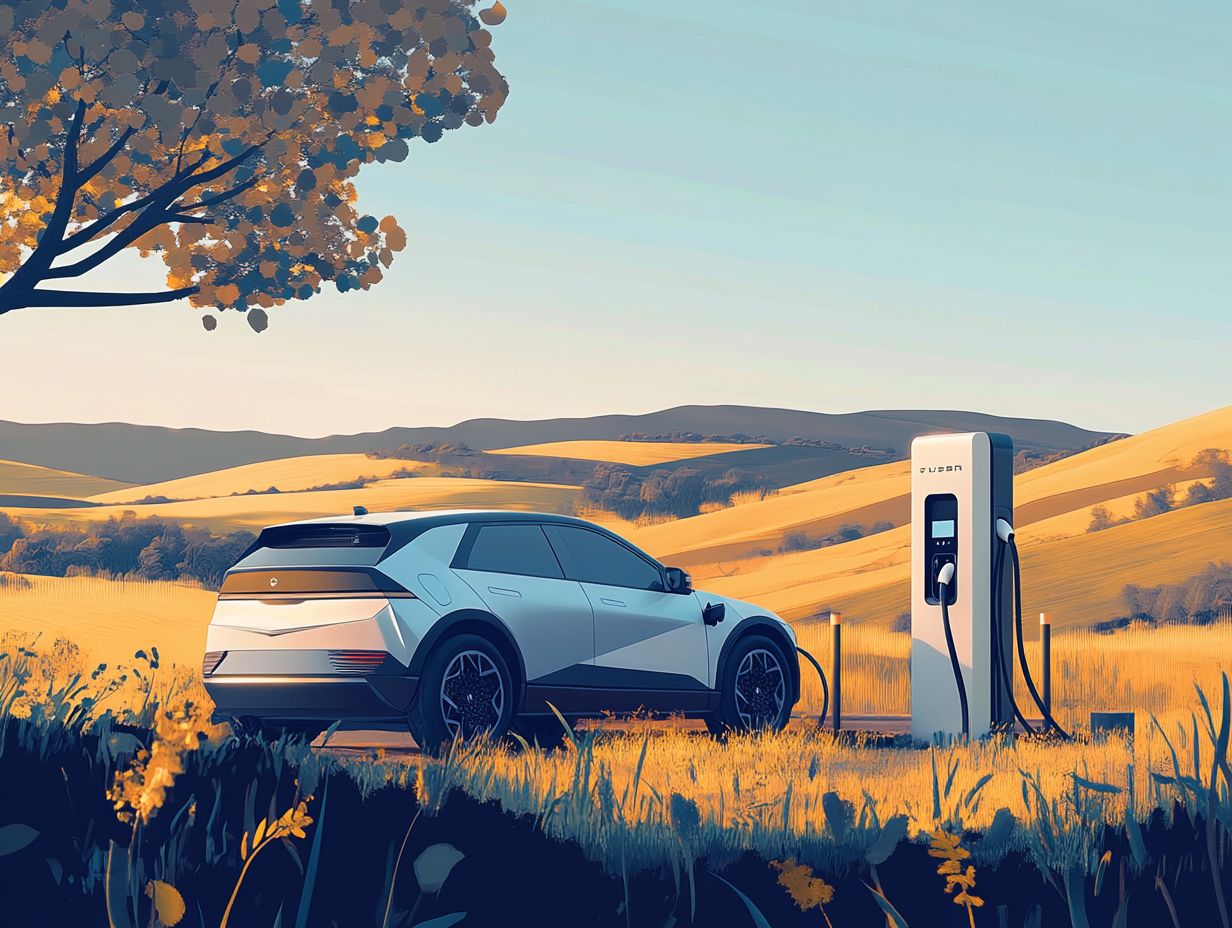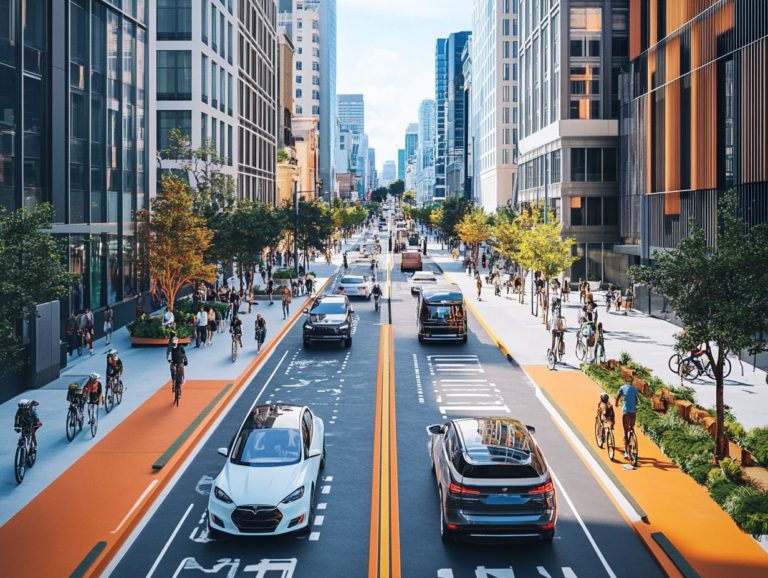The State of EV Adoption in Rural Areas
As electric vehicles (EVs) gain momentum, their potential benefits from reducing environmental impact to realizing cost savings become strikingly evident.
In rural areas, however, unique challenges arise in embracing this technology. These include limited infrastructure and a narrower selection of vehicles.
Despite these obstacles, numerous initiatives are actively promoting EV adoption. This effort is bolstered by government incentives and partnerships with utilities.
This article delves into the current landscape of EV adoption in rural communities. It showcases success stories that reflect progress and explores potential solutions for a greener future.
Contents
- Key Takeaways:
- The Benefits of Electric Vehicles (EVs)
- Barriers to EV Adoption in Rural Areas
- Efforts to Promote EV Adoption in Rural Areas
- Success Stories of EV Adoption in Rural Areas
- The Future of EV Adoption in Rural Areas
- Frequently Asked Questions
- What is the current state of EV adoption in rural areas?
- Are there any programs to help increase EV adoption in rural areas?
- What are some challenges that hinder EV adoption in rural areas?
- How does the state of EV adoption in rural areas affect the overall transition to electric vehicles?
- What can be done to increase EV adoption in rural areas?
- Are there any benefits to increasing EV adoption in rural areas?
Key Takeaways:

- EVs offer both environmental and cost-saving benefits. They are a valuable option for rural areas.
- Lack of charging stations and limited vehicle options are major barriers to EV adoption in rural areas.
- Government incentives and collaborations with utilities promote EV adoption in rural communities.
The Benefits of Electric Vehicles (EVs)
Electric vehicles (EVs) like the Volkswagen ID4 and Ford F-150 Lightning present a wealth of advantages. They enhance environmental sustainability and deliver economic savings for families.
As rural Americans increasingly embrace EVs, these vehicles are vital in diminishing climate pollution. They pave the way for a more sustainable future.
By recognizing the benefits of EV ownership such as reduced gasoline consumption and lower maintenance costs you play a key role in encouraging greater EV adoption. This fosters environmental justice and propels progress toward a cleaner energy mix.
Environmental Benefits
The environmental benefits of electric vehicles (EVs) are remarkable. They play a crucial role in reducing climate pollution and lowering vehicle emissions compared to traditional gas-powered cars like the Honda.
By making the switch to EVs, you actively contribute to a cleaner atmosphere. Studies reveal that EVs can cut transport-related emissions by up to 70% when powered by renewable energy sources.
According to the Coltura report, the average EV can save you over 1,000 pounds of CO2 emissions annually. This highlights their importance in promoting sustainable practices.
This transition not only helps combat the impacts of climate change. It also encourages significant investments in cleaner energy infrastructure, paving the way for a greener future for generations to come.
Cost Savings
Electric vehicles (EVs) can open the door to impressive cost savings for your family. This is especially true with the generous support of the Inflation Reduction Act, which offers enticing tax credits for owning an EV.
Beyond these incentives, the reduced maintenance costs associated with EVs contribute significantly to your overall savings. Unlike traditional gasoline vehicles, EVs have fewer moving parts.
This translates to less wear and tear and a lower chance of those unexpected, costly repairs. With charging infrastructure continuously expanding, you can enjoy the convenience of home charging at a fraction of the price of gasoline.
When you consider these financial benefits alongside available rebates and tax credits, making the switch to electric vehicles is not just an environmentally conscious choice. It is also a savvy economic decision for families eager to save money in the long run!
Barriers to EV Adoption in Rural Areas
Despite the myriad advantages of electric vehicles (EVs), rural Americans encounter significant barriers to EV adoption. These challenges must be addressed to ensure equitable access to sustainable transportation.
A primary concern is the lack of charging stations in rural areas. This creates range anxiety, or the fear of running out of battery power before reaching a charging station.
The limited selection of vehicles can also hinder adoption. This situation highlights the urgent need for improved mobility infrastructure and focused outreach efforts to facilitate this transition.
Lack of Infrastructure

A notable barrier to the adoption of electric vehicles (EVs) in rural areas is the insufficient charging infrastructure. This complicates both charging logistics and accessibility.
This scarcity creates unease among rural drivers who might otherwise consider switching to electric vehicles. The worry about running out of battery before finding a charging station often dissuades them from exploring the advantages of EV ownership.
To tackle this challenge, consider innovative solutions like deploying mobile charging units or encouraging local businesses to install charging stations. By fostering partnerships between government agencies and private enterprises, a network of chargers can be established that specifically meets the needs of rural communities.
This effort could ultimately encourage more individuals like you to embrace eco-friendly transportation options.
Limited Vehicle Options
Limited vehicle options in the electric vehicle market can feel like a significant hurdle for you as a rural American trying to shift away from gas-powered vehicles.
However, the landscape is evolving. A growing variety of electric models is now available, including versatile electric trucks designed specifically for the needs of farmers and tradespeople.
Leading manufacturers, such as Tesla and Ford’s electric F-150, are expanding your choices.
This enhanced selection not only provides practical solutions tailored to rural lifestyles, but also alleviates concerns about range and functionality.
As more electric vehicles become available, they pave the way for broader acceptance, making it increasingly feasible for you to consider leaving traditional combustion engines behind.
Efforts to Promote EV Adoption in Rural Areas
To tackle the barriers hindering electric vehicle (EV) adoption in rural areas, many initiatives are underway. These include government incentives and community outreach programs designed to elevate awareness and enhance access to EVs.
Government Incentives
Government incentives, like tax credits and programs highlighted in the Inflation Reduction Act, are essential for boosting electric vehicle (EV) registration and adoption.
These financial benefits significantly reduce the overall cost of ownership, making it much more attainable for you and your family to shift toward cleaner transportation options.
In rural areas, where traditional vehicles are prevalent due to longer distances and limited infrastructure, these incentives can help offset initial purchase prices and improve the installation of charging stations.
Regions with strong incentive programs have seen a remarkable uptick in EV registrations, creating a sense of community and championing environmental sustainability.
This urgent transition not only boosts local economies but also addresses pressing concerns about air quality and climate change, underscoring the far-reaching impacts of such government initiatives.
Collaborations with Utilities
Local governments and utilities must collaborate to enhance charging infrastructure and promote community outreach programs that encourage EV adoption.
By pooling resources, these partnerships effectively identify high-traffic areas for new charging stations, ensuring that rural communities are not overlooked in the transition toward electric vehicles.
Utilities bring technical expertise and funding to the table, while municipalities streamline permitting processes and engage local stakeholders.
Community outreach initiatives are pivotal in educating residents about the benefits of EV ownership. They address concerns like the worry about running out of battery before finding a charging station and spotlight available incentives.
Through workshops and informational sessions, you can empower residents to make informed choices about their transportation options, ultimately fostering greater acceptance and use of electric vehicles in these communities.
Success Stories of EV Adoption in Rural Areas

Success stories from rural communities across the United States highlight the increasing acceptance and adoption of electric vehicles (EVs). These narratives showcase innovative strategies and collaborative efforts that have paved the way for positive outcomes.
They illustrate the remarkable potential of community-driven initiatives in the shift toward sustainable transportation.
Case Studies of Rural Communities Embracing EVs
Several compelling case studies showcase how rural communities are successfully embracing electric vehicles (EVs) through innovative solutions. These include public transit initiatives and the integration of models like Tesla.
In these regions, local governments and organizations have come together to develop infrastructure that supports EV usage. They feature strategically placed charging stations in public spaces.
One exemplary case highlights a small town where community workshops raised awareness about the benefits of EVs. This sparked a grassroots movement that encouraged residents to explore electric car options as viable alternatives to traditional vehicles.
Public transit systems are integrating electric buses to enhance transport options while significantly reducing emissions. This results in a more sustainable transportation network.
The collaborative efforts of local stakeholders have improved the accessibility of electric mobility. They have also nurtured a sense of community engagement and environmental responsibility among residents.
The Future of EV Adoption in Rural Areas
The future of electric vehicle (EV) adoption in rural areas is bright and full of opportunities! Innovative solutions are emerging to tackle existing barriers.
These solutions enhance transport options within your community and alleviate the economic burden tied to transportation.
This evolution not only paves the way for a more sustainable future but also enriches your daily life. It makes travel more accessible and efficient.
Potential Solutions to Overcome Barriers
Identifying potential solutions to break down barriers to EV adoption is essential. This ensures that rural communities fully embrace the transition to electric vehicles.
This journey involves tackling several challenges, such as limited charging infrastructure and a general lack of awareness about the advantages of EV ownership.
Innovative strategies like community solar projects solar energy projects that benefit the community and mobile charging stations can enhance accessibility significantly.
By forming partnerships with local governments, businesses, and non-profits, you can cultivate a collaborative approach that amplifies outreach efforts.
Educational campaigns emphasizing the environmental benefits and cost savings associated with electric vehicles can motivate residents to explore alternative transportation options. By leveraging these strategies, rural areas can establish a sustainable ecosystem that supports widespread EV adoption.
Expected Impact on Rural Communities
The anticipated impact of increased electric vehicle (EV) adoption in rural communities extends beyond economic benefits. It paves the way for a sustainable future and fosters environmental justice.
By seamlessly integrating EVs into local transportation networks, you can unlock enhanced transport options that are cost-effective and environmentally friendly.
This shift has the potential to ignite local job creation, as the maintenance and charging infrastructure need a skilled workforce. Reduced reliance on fossil fuels improves air quality, leading to better health outcomes for residents.
Ensuring equitable access to electric transportation solutions is vital. This addresses the mobility disparities between urban and rural areas.
This approach guarantees that every community member can reap the rewards of cleaner technologies and seize economic opportunities.
Frequently Asked Questions

Join your local initiatives and support the move towards electric vehicles!
What is the current state of EV adoption in rural areas?
The current state of EV adoption in rural areas is still relatively low compared to urban areas.
This is due to various factors such as limited infrastructure and lack of incentives. Additionally, there is a lower availability of EV models.
Are there any programs to help increase EV adoption in rural areas?
Yes, there are several programs aimed at boosting EV adoption in rural areas.
Examples include government incentives for EV purchases and building charging infrastructure in rural communities.
Educational campaigns are also being conducted to raise awareness about EVs.
What are some challenges that hinder EV adoption in rural areas?
Understanding the hurdles is crucial to finding solutions. Some challenges include the lack of charging infrastructure and longer driving distances.
Limited access to EV models poses another challenge. Higher upfront costs of EVs are another barrier for rural residents.
How does the state of EV adoption in rural areas affect the overall transition to electric vehicles?
The slower adoption of EVs in rural areas can hinder the overall transition to electric vehicles.
Rural areas make up a significant portion of the country’s land area, and a higher demand for EVs in these areas can help drive down costs.
This improved demand can also enhance infrastructure for the entire country.
What can be done to increase EV adoption in rural areas?
To increase EV adoption in rural areas, we need a combination of efforts from the government, automakers, and community organizations.
This can include providing incentives for EV purchases and expanding charging infrastructure.
Let’s work together to make EVs more accessible in rural communities!
Are there any benefits to increasing EV adoption in rural areas?
Increasing EV adoption in rural areas can transform communities!
It leads to cleaner air, less reliance on fossil fuels, and creates new job opportunities in the EV industry.






